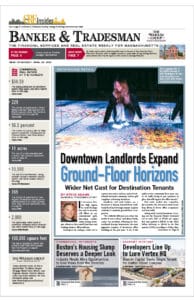With home prices spiraling upwards and stories about the growing single-family rental industry percolating in local and national media alike, concern is rising about the impact institutional investors might be having on the housing market.
But are there really that many in Massachusetts? New research from the National Association of Realtors’ economics team sheds light on the question.
NAR researchers used property deeds provided by real estate data firm Black Knight to estimate institutional buyers’ market share in counties across the nation in 2020 and 2021, and announced their findings Tuesday.
Nation-wide, institutional buyers – which researchers defined as “companies, corporations, or LLCs” – made up 13.2 percent of residential purchases in 2021, and saw their market share grow in nearly all states compared to 2020. However, while this is an increase of 1.5 percentage points over 2020, it is far from a high. The NAR report says investors made up between 14 percent and 15.7 percent of all residential purchases between 2011 and 2019.
The median price these buyers paid was typically 26 percent below the state median price, NAR said, but that shrank to 20 percent in states where more than 13 percent of homes were sold to institutional buyers. Below that threshold, it sank to 30 percent.
The research also found evidence that these institutional investors were helping tighten the housing market. In counties where the investor share was higher than the national average, listings were down 7 percent year-over-year as of March 2022, whereas listings were only down 4 percent year-over-year in counties where the share of institutional buyers was below the national average. And areas where institutional investors were more active in buying homes, renters made up 30 percent of households on average, compared to 27 percent of households where institutional investors weren’t as active.
Compared to many Sun Belt states, Massachusetts has hardly any institutional buyers according to the NAR report. Only 7 percent of all residential properties were sold to one in 2021, with the highest concentrations occurring on Martha’s Vineyard (15 percent), Nantucket (13 percent) and Suffolk County (12 percent). Institutional investors made up only 8 percent of buyers in Berkshire and Hampden counties; 7 percent in Barnstable and Middlesex counties; 6 percent in Bristol, Franklin, Hampshire and Worcester counties; and 5 percent in Essex, Norfolk and Plymouth counties.
Nantucket was recently the site of a major debate over regulations on short-term rental regulations triggered in part by a venture by Boston-based developer Copley Group to buy high-end homes and rent them out to wealthy vacationers. Strong restrictions were eventually voted down by Nantucket’s Town Meeting.
Texas dominated the state-by-state rankings of institutional investor market share, buying fully 28 percent of residential sales last year, followed by Georgia (19 percent) and Oklahoma and Alabama tied at 18 percent.
NAR researchers said that several factors likely determined this, including institutional investors’ apparent preference for areas where many people were starting families or moving into the area, and where many residents were Black, Millennials, renters, had high incomes and education. Fast rent growth, a low rental vacancy rate and fast home sales growth also appeared to attract institutional buyers.







